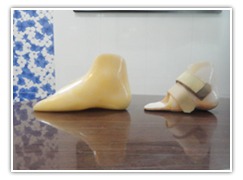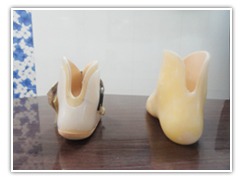Ped Orthotics
Hind-foot control consists of orthoses that control the location of the hind-foot and mid-foot to provide a stable support base.
Hindfoot Control Orthoses
Supra Melleolar Orthosis (SMO)
Recommended For:
Significant instability of the forefoot, mid-foot, and subtalar
Owing to low or high tone, global foot deviations
Deviations of the foot that interfere with posture and balance
Young children that require free dorsiflexion and plantarflexion for crawling, pulling to stand, and squatting require considerable foot instability.
SMO’S (Supra Mulleolar Orthosis)
SMO improves mechanical control, especially in the coronal plane Saggital plane restricted control.
Improved Efficiency
Children who, in an effort to counter imbalances induced by pronation-related instabilities, transmit a lot of energy through their feet, legs, and upper body. The SPORC Design system helps to stabilize the foot and ankle when worn, which decreases the need for substantial compensation for balance. It is now possible to redirect to durability the energy that was increased by preserving equilibrium.
Increased Stability
Although several different styles of orthoses are attempting to correct low tone pronation, the special, proprietary principle of compressing the foot into neutral alignment is used only by the SPORC Design system. The SPORC Design system is made of an incredibly lightweight and durable plastic that allows the pressure to be distributed uniformly around the foot, providing a form of hydrostatic compression inside the walls of the SPORC Design system. This truly dynamic principle helps the foot and ankle to shift more naturally while maintaining proper alignment through standing, walking and running.
Better Alignment
Excessive pronation by adjusting the alignment of the lower extremities places undue stress on the knees and hips. This may be the cause of reduced stamina and the report of “tired legs” frequently heard from children who speak. The SPORC design system allows the foot and ankle to stabilize, which allows alleviating tension from the joints of the knee and hip.
More Fun
More physical operations are now possible for your child due to the special, proprietary trim lines of the SPORC Design. It makes playtime more fun to squat, hop, and run!
More Natural Development of Balance Reactions
A hard barrier between the foot and the floor is formed by conventional rigid bracing. These rigid barriers decrease the normal functioning of the joint receptors and, in turn, hinder the natural production of balance reactions. For children with poor muscle tone, this has strengthened the reluctance of many doctors and physical therapists to prescribe bracing. The special thermoplastic properties used in the manufacture of the SPORC Design system make it possible for the foot to travel naturally without limiting intrinsic movements. This promotes the production of reactions to balance and the foot ‘s intrinsic musculature.







